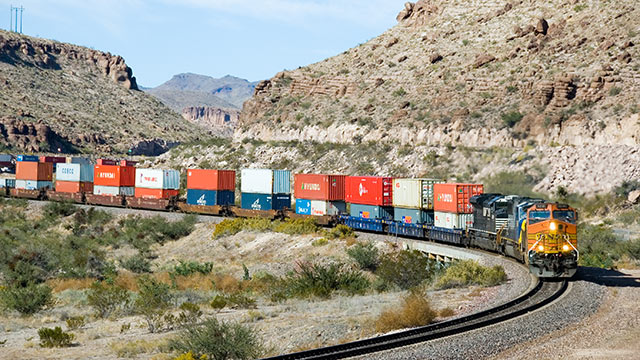Even as other parts of the U.S. supply chain faced disruptions and setbacks, the freight rail industry demonstrated resilience and reliability during the COVID-19 pandemic, according to a new report by the Northwestern University Transportation Center (NUTC).
Despite the particularly volatile period, railroads met consumers’ and businesses’ unexpected surge of demands, reliably delivering goods such as agricultural products, personal protective equipment and online retail merchandise and ultimately highlighting the rail industry’s role as an essential component of the U.S. economy.

Now available online, the report was prepared by Northwestern transportation and infrastructure experts Joseph Schofer, Hani Mahmassani, Max Ng and Breton Johnson. In the study, the co-authors analyzed shipment data, reviewed research literature and gathered insights from in-depth interviews with leaders of railroads, intermodal carriers, rail equipment manufacturers, car-leasing companies, shippers and major e-commerce companies.
Among their findings, the researchers noted that freight rail kept goods moving while facing supply chain disruptions — such as port congestion, chassis shortages and truck freight load rejections — whereas other methods of transport were constrained or delayed. Informed regulatory policy at the federal, state and local levels, coupled with continued operational innovation across the freight rail network, can ensure continued industry strength through an unpredictable future, the co-authors said.
“The role of intermodal rail service in support of consumers’ COVID-19-driven jump from in-person buying experiences to online shopping underscores the value of the railroads to American households,” said Schofer, professor of civil and environmental engineering at Northwestern’s McCormick School of Engineering.

“Railroads proved to be nimble and flexible in dealing with the pandemic disruptions and post-pandemic surges in demand, fulfilling their key role to keep the nation’s supply chains moving,” said Mahmassani, NUTC director and the William A. Patterson Distinguished Chair in Transportation at McCormick.
In-depth interviews point to rail’s essential role in accommodating the pandemic’s rapid growth in intermodal traffic, which stemmed largely from heightened e-commerce use. NUTC's analysis shows that 2020 intermodal rail freight exceeded pre-pandemic expectations, driving Q3 and Q4 volumes to surpass their 2019 and 2018 levels. This strong growth builds on the e-commerce industry’s expansion over the last two decades, during which it grew by 70%.
Experts predict that consumers who turned to e-commerce during the pandemic likely will continue shopping online in the future, solidifying freight rail’s key role in the e-commerce supply chain for years to come.
“Freight rail is a crucial part our nation's supply chain and transportation system, operating as a link between American businesses and consumers,” said Ian Jefferies, president and CEO of the Association of American Railroads (AAR). “The unprecedented events of the last year have reminded us that the massive private investment of railroads over the years — combined with continued innovation — has positioned railroads well to meet growing freight demand and unexpected challenges. NUTC’s important research underscores the unique responsibility that freight railroads hold and illuminates the ways in which we can support recovery and a strong economic future.”
The report, “The U.S. Railroads and COVID-19: Keeping Supply Chains Moving,” includes contributions from the (AAR) through the provision of data and guidance.


